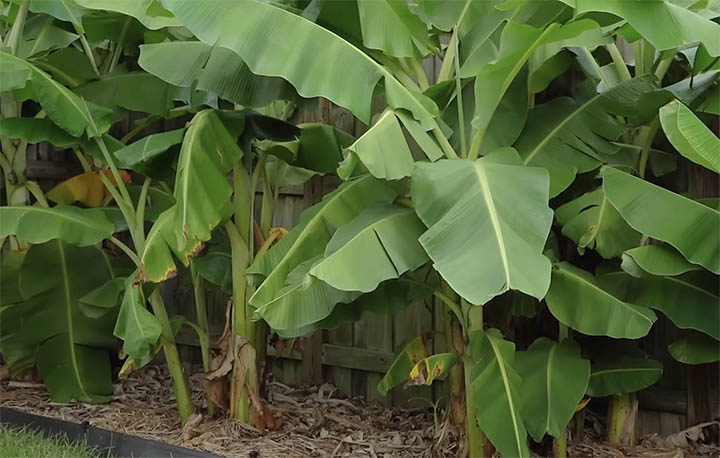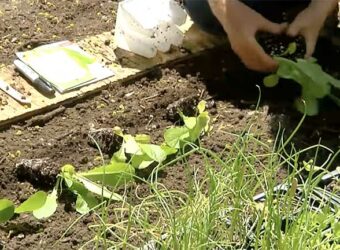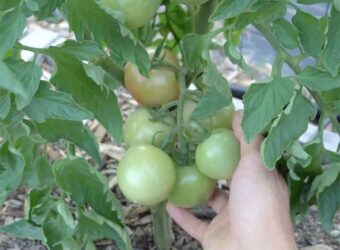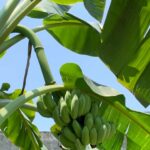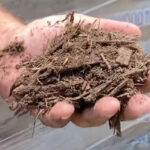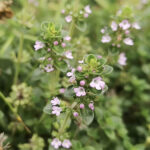If you want to grow a healthy banana tree, you need to ensure your plant has all the nutrients it needs. Often, that means you’ll need to apply fertilizer.
However, with thousands of different fertilizers available, choosing the right one for your banana tree can be difficult! We will introduce you to banana fertilizers basics and then provide you with a list of four great banana tree fertilizers.
What Do Banana Trees Need Nutrients?
Banana plants, like all plants, require various nutrients to grow and flourish. If you want a healthy plant and dream of harvesting bunches of bananas, you’ll need to make sure your plant has access to the necessary nutrients.
You can classify nutrients into three main categories: macronutrients, secondary nutrients, and micronutrients. Macronutrients are nutrients that are required in relatively large quantities, secondary nutrients are required in slightly smaller quantities, and micronutrients are required in even smaller quantities.
We’ll take a look at each of these nutrient categories to help you better understand banana plant nutrient needs.
All plants require macronutrients in order to complete basic growth and development. That means if your banana is lacking any of the three macronutrients, it will eventually show signs of poor growth or vigor.
While you may not realize it, you probably already know the three plant macronutrients: nitrogen (N), phosphorus (P), and potassium (K). These nutrients are often included on fertilizer labels in the form of an NPK ratio.
Macronutrients
Nitrogen is a major component of many important plant molecules, including chlorophyll, various enzymes, and structural proteins. That means nitrogen is essential for leaf and stem growth as well as the completion of photosynthesis.
If your banana plant doesn’t have access to enough nitrogen, you may notice the older leaves becoming light green and eventually yellow. Your plant may also seem stunted, even if environmental factors like temperature and light seem ideal.
Phosphorus is a major part of the energy storage and transfer molecule known as ATP. Plants use ATP to release the energy necessary to move molecules throughout the plant, complete photosynthesis, and send messages within and between cells.
Without enough phosphorus, banana plants may have a difficult time growing strong roots, forming flowers, and fighting off pests. Some signs of phosphorus deficiency in banana plants include a blueish-green coloration on older leaves, yellowing or browning of leaf margins, and reduced leaf production.
The final macronutrient, potassium, is not a structural nutrient but is rather used as a messenger within plants. It helps regulate the movement of water, the opening and closing of leaf pores known as stomata, and the movement of nutrients.
Secondary Nutrients
Banana plants require the next group of nutrients, secondary nutrients, in moderate amounts. These elements include calcium, magnesium, and sulfur.
Calcium plays a major role in the development of plant cell walls. Therefore, calcium-deficient banana plants may exhibit misshapen or stunted leaves. Since calcium is an immobile nutrient, these signs will first appear in younger leaves.
Magnesium is located in the center of each chlorophyll molecule, which means it is essential for the completion of photosynthesis. If a banana plant lacks magnesium, it may have difficulty completing photosynthesis. In turn, plants may appear weak, stunted, or discolored.
Sulfur helps form chlorophyll and activate enzymes, and it is also a structural component of some amino acids. A lack of sulfur may make new leaves pale green or yellow.
Micronutrients
The remaining nutrients plants require are known as micronutrients. These nutrients are only needed in very small amounts, but a lack of any of these nutrients can lead to minor or major issues with your banana plant.
The seven micronutrients are iron (Fe), manganese (Mn), zinc (Zn), copper (Cu), boron (B), molybdenum (Mo), and chlorine (Cl).
Since there are so many micronutrients and they’re only needed in very small amounts, I won’t cover the role of each one. However, they serve functions ranging from enzyme activation to the uptake of other nutrients to the maintenance of cell walls.
What to Look for In a Great Banana Fertilizer
As you’ve read, banana plants require many different nutrients to thrive! While some of these nutrients may be naturally present in your soil, you may need to apply fertilizer to add additional nutrients.
Before you just grab any fertilizer off the shelf, we’re going to introduce you to some items you should consider when choosing a banana fertilizer.
Nutrient Composition
When choosing a banana fertilizer, you’ll want to think about the specific nutrient needs of your banana plant. Each type of plant has different nutrient needs, which explains why you can find various fertilizers designed for specific plants.
That begs the question, how many of each nutrient does a banana plant need?
Since bananas grow to be large plants, they require a high dose of potassium throughout their life cycle. This nutrient allows plants to move water and nutrients as they grow and develop fruit.
Banana plants also require a moderate amount of nitrogen. While they require nitrogen throughout their life cycle, it’s good advice to apply a higher amount of this nutrient during the plant’s first few months of growth.
When it comes to phosphorus, you’ll want to look at your timing. Banana plants require lots of phosphorus during their first few months of growth, but this need eventually diminishes.
So, how do you ensure you’re applying the right amounts of these macronutrients? Look at the NPK ratio, which explains the proportion of nitrogen, phosphorus, and potassium in the fertilizer. Most fertilizers will display their NPK ratio on their labels, making choosing a product with the proper ratio easy.
Remember that banana plants require a large amount of potassium, a smaller amount of nitrogen, and an even smaller amount of phosphorus. Therefore, you should look for a fertilizer with an NPK close to 15-4-20 or 10-3-15, or 10-5-20.
In addition to the NPK ratio, selecting a fertilizer that contains secondary nutrients and micronutrients is also a good idea. You can also apply one product to supply macronutrients and another fertilizer to supply these other nutrients.
Product Form
Fertilizers typically come in one of two forms: granular and liquid. One product isn’t necessarily better than the other, but there are some differences you should consider.
Granular fertilizer is often less messy and easier to clean up if spills occur. You apply this type of fertilizer by sprinkling it on the soil and then watering it in.
Depending on the product, granular fertilizer may be quick-release or slow-release, aka extended-release. All of the nutrients in a quick-release fertilizer will be available to plants within a few days, While a slow-release fertilizer slowly makes nutrients available to plants over time.
Typically, you can get away with applying slow-release fertilizers less often. However, they will not provide large doses of nutrients if your plant needs a boost of nutrients ASAP.
Liquid fertilizer is typically supplied in a concentrated form. To apply, you dilute the product in water and then apply it to your plant.
Organic or Synthetic
Another main difference between banana fertilizers is whether they are organic or synthetic. While both of these types of fertilizers supply the same nutrients, they source the nutrients from different places.
Organic fertilizers consist of naturally occurring materials. These materials include manure, rock dust, fish bones, feathers, and kelp.
Synthetic fertilizers, on the other hand, are synthesized in a lab.
It’s important to recognize that while organic and synthetic fertilizers can supply nutrients like nitrogen and phosphorus, they supply different amounts and types of these nutrients.
To hammer this point home, let’s look at nitrogen.
If you want to use an organic nitrogen source, you may choose to use blood meal, which contains 13% nitrogen, or feather meal, which contains 12% nitrogen.
While feather meal contains nitrogen, this nitrogen is not immediately available to plants. That’s because bacteria must first break down the complex nitrogen molecules into simpler nitrogen compounds like ammonium and nitrate that plants can take up.
The nitrogen in blood meal is available to plants more quickly than the nitrogen in feather meal. However, plants will not be able to access the nitrogen present in blood meal as soon as you apply it to the soil.
But what about synthetic nitrogen, you ask? Well, that’s completely different.
If you choose the synthetic route, you may apply urea (46% nitrogen) or ammonium nitrate (32% nitrogen). These fertilizers quickly break down into small nitrogen compounds that plants can take up, which means they quickly supply nitrogen to plants.
How to Fertilize Banana Trees
When you’re determining how to fertilize banana trees, you’ll need to consider the type of fertilizer you’re using. You should mix granular fertilizers into the top few inches of soil, insert fertilizer spikes into the ground, and pour diluted liquid fertilizer around the base of the plant.
How often to fertilize banana trees also depends on the product you’re using. Generally, you will want to fertilize from the early spring through early fall, but not during the late fall and winter.
You should aim to apply quick-release fertilizers about once a month and slow-release fertilizers once in the early spring and again at the beginning to middle of summer.
The Best Fertilizers for Banana Trees
With all the above information in mind, you’re probably wondering what the best banana tree fertilizers are. I’m going to introduce you to four products that can work well for banana trees.
1. Fruit Fuel from Grow More – Best Complete Banana Fertilizer

Fruit Fuel from Grow More is an excellent product if you’re looking for a well-balanced banana fertilizer that also delivers a dose of secondary nutrients and micronutrients.
Cost
At the time of writing, five pounds of Fruit Fuel cost $37.97 on Amazon.com. This translates to $0.47 per ounce.
It’s important to remember that Fruit Fuel contains a relatively high amount of nutrients, so while the cost may seem high, you’re getting a pretty good bang for your buck.
Benefits
I think one of the biggest selling points of Fruit Fuel is the great NPK ratio as well as included secondary nutrients and micronutrients. In short, it contains all the nutrients your banana tree needs without oversupplying nutrients.
It has an NPK ratio of 16-8-24, which is in line with the ideal ratio. This large amount of potassium will help the plant move water and send important messages throughout its growing cycle, the nitrogen will help plant growth and protein formation, and the phosphorus will help develop roots and fight off disease.
Along with these macronutrients, it contains calcium, magnesium, sulfur, boron, copper, iron, manganese, molybdenum, zinc, and cobalt. That means it supplies your banana tree with almost all the nutrients it needs to thrive.
The product is also easily available online, which makes it easy to order and use, no matter where you live.
Drawbacks
While it’s not necessarily a drawback, this product is not organic. Therefore, if you’re looking to use organic methods, this product will not work for you.
I’ve noticed that some people also report that the granules can quickly turn into a solid chunk, which makes it difficult to mix the product with water. Rather than relying on the product’s original flimsy packaging, you can reseal your product in a ziplock plastic bag.
Comparing to Other Products
Fruit Fuel provides a more complete dose of nutrients than other fertilizers in this list. That means you are unlikely to deal with deficiencies in secondary nutrients like sulfur and magnesium or micronutrients like boron and iron.
It also contains an NPK ratio that is the closest to what banana trees love. So if you’re most concerned about supplying the right nutrients, this might be the product for you.
Most of its nutrients are also immediately available to plants, differentiating it from Espoma Organics Palm Tone and Jobe’s Palm Tree Fertilizer Spikes. This means that Fruit Fuel can quickly supply your plant with necessary nutrients, but it will not feed your plant over an extended period of time.
Applying this fertilizer is a bit different than others on the list. Rather than sprinkling the granules on the ground and then watering, package directions suggest mixing one tablespoon of fertilizer per gallon of water and then applying this mixture to your banana plant.
That means that if you have a very large banana plant or have a difficult time lifting heavy objects, this might not be the best product for you.
2. Espoma Organics Palm Tone – Best Organic Banana Fertilizer

While you may be tempted to reach for an organic product labeled for use on fruit trees, it’s important to remember that a banana plant technically isn’t a tree. A palm fertilizer like Espoma Organics Palm Tone will be a better choice for banana plants than many other organic alternatives.
Cost
At the time of writing, a four-pound bag of Palm Tone cost $14.35, which equates to about $0.22/ounce. While this per-ounce price may seem low, it’s important to remember that this product contains a lower amount of nutrients than the other products on this list.
Benefits
Espoma Organics Palm Tone contains an NPK ratio of 4-1-5, which aligns with what a banana tree likes. It contains a lot of potassium, a bit smaller amount of nitrogen, and just a touch of phosphorus.
The ratio means that you are supplying your plant with the nutrients it needs while not wasting money on excess phosphorus or nitrogen.
It also contains all of the secondary nutrients and numerous beneficial bacteria. Adding these bacteria to the soil can help convert organic nutrients into forms plants can take up, help plants fight off pathogens, and help banana plants tolerate environmental stressors.
Finally, this fertilizer contains humic acid. This material can help improve soil structure and water and nutrient uptake.
Many people also consider this fertilizer’s organic form a benefit. It is made from natural materials rather than synthetic materials that were synthesized in a lab using fossil fuels.
Drawbacks
Since this product is derived from organic materials, it doesn’t supply a huge dose of nutrients. That means you will need to apply more of this product than you would most synthetic fertilizers.
Another drawback is the slow release of nutrients. Bacteria must break down the nutrients present in this fertilizer before the banana plant can take them up. This process is dependent on environmental conditions, including temperature and moisture.
That means that your banana plant may have difficulty accessing the nutrients in this fertilizer if you apply it during cooler spring months.
A final potential drawback is the high cost. Although the product may not seem expensive per ounce, you will need to consider the lower nutrient content when you are thinking about the cost.
Comparing to Other Products
Palm Tone is the only product on this list that is made from organic materials. If growing using organic methods and materials is important to you, you’ll want to choose this fertilizer to use on your banana trees!
While Palm Tone isn’t labeled as a slow-release fertilizer, it will supply nutrients more slowly than Miracle-Gro Palm Tree Food and Fruit Fuel. So if you’re looking to boost your banana tree with nutrients ASAP, Palm Tone may not be the best bet.
The nutrients in Palm Tone are also more dependent on environmental conditions than the nutrients present in the other fertilizers on this list.
3. Jobe’s Palm Tree Fertilizer Spikes – Best Fertilizer Spikes for Banana Trees

If you have difficulty remembering to apply fertilizer, you may like Jobe’s Palm Tree Fertilizer Spikes. After you apply the spikes in the ground, they will slowly release nutrients over the course of multiple months.
Cost
At the time of publishing, a one pound and five-spike package cost $16.71 on Amazon. That equals out to about $3.34 per spike or about $1.04/ounce.
You could save a bit of money by purchasing a larger container of spikes. For example, buying a pack of ten five-spike packages cost $98.85, which translates to about $1.98 per spike.
Benefits
One of the big benefits of this fertilizer is its set-it-and-forget-it design. Even if you know you should fertilize your banana plant every month during the growing season, it can be hard to remember to do so!
If you utilize these fertilizer spikes, you will only need to insert them into the soil around your banana tree twice a year. That means that you are less likely to forget to supply your plant with the nutrients it needs.
Once you apply the spikes, about one-third of the nutrients will be immediately available to plants. The remaining two-thirds will be slowly released over time.
Another benefit of this product is its extremely simple application. Just insert the correct number of spikes into the ground around your tree!
One final benefit is the fact that the product includes some secondary nutrients and micronutrients.
Drawbacks
While these fertilizer spikes have an NPK ratio that is close to what banana plants prefer, it isn’t spot on. The NPK ratio of 10-5-10 means that you will likely be over-applying phosphorus and nitrogen if you want to supply your banana plants with all the potassium they need.
Another drawback is the product’s lack of calcium. Since it contains 0% calcium, which is an important secondary nutrient, you may find that you need to add another fertilizer in order to supply your banana trees with calcium.
Finally, it’s important to note that most of the nutrients in these fertilizer spikes are in a slow-release form. While this isn’t necessarily a drawback, you need to be aware that not all of the nutrients in the plant will be immediately available to your banana tree.
Comparing to Other Products
This product falls somewhere in the middle regarding the nutrients it supplies. It supplies more nitrogen, potassium, and phosphorus than a similar weight of Espoma Palm Tone, but fewer nutrients than the same amount of Fruit Fuel and Miracle-Gro Palm Tree Food.
While both Miracle-Gro Palm Tree Food, Fruit Fuel, and these Palm Tree Fertilizer Spikes are all made from synthetic materials, they release their nutrients at different rates. The first two products contain most of their nutrients in a form that is immediately available to plants.
However, these fertilizer spikes hold most nutrients in a slow-release formula. That means you can apply more nutrients at once without worrying about burning your plant.
4. Miracle-Gro Palm Tree Food – Best Value Banana Fertilizer

If you’re looking for a low-cost option, check out Miracle-Gro Palm Tree Food. Although this product is designed for palm trees rather than banana trees, it will provide the fruiting plants with many of the nutrients they require to thrive.
Cost
Here’s where this product shines! A 20-pound bag of Miracle-Gro Palm Tree Food costs $21.95 at the time of publishing, which equals about $0.07 per ounce.
While this product doesn’t contain tons of nutrients per weight, it is still a cost-effective option.
Benefits
Miracle-Gro Palm Tree Food is a no-frills and affordable option that can help you supply your banana tree with some of the nutrients it needs. It contains more potassium and nitrogen than phosphorus, which banana trees like.
This product is also easy to apply. All you have to do is sprinkle the fertilizer around the base of your plant and then mix it into the top few inches of soil.
Once you do that, the product will supply your plant with nutrients for about six weeks. That means you don’t have to worry about reapplying fertilizer too often.
You can also find Miracle-Gro Palm Tree Food in a wide variety of sizes, so you can select an option that’s right for you. If you have a lot of trees or want the lowest
Drawbacks
While the NPK ratio of this product isn’t totally off of what a banana plant likes, it isn’t completely in line. The 8-4-8 ratio means that this fertilizer will apply a bit more nitrogen and phosphorus than the plant needs if you apply the amount of product required to meet potassium needs.
Another drawback is the lack of secondary nutrients and micronutrients.
This fertilizer contains magnesium, manganese, and iron but lacks other secondary nutrients and micronutrients. That means your banana plant may lack sulfur, calcium, and other elements unless you apply another fertilizer alongside Miracle-Gro Palm Tree Food.
Comparing to Other Products
As you can probably tell by the “best value” label, this product is less expensive than the other products on the list. Even when you account for the higher nutrient content of Fruit Fuel, this Miracle-Gro product comes out on top when it comes to cost.
However, it contains fewer secondary nutrients and micronutrients than the other products on the list. That means that you may need to apply another fertilizer to supply your banana tree with all the nutrients it needs.
Its NPK ratio is also different from other products in the list. It isn’t as close to a banana tree’s ideal ratio as Fruit Fuel, but the ratio is similar to that of the Palm Tree Fertilizer Spikes.
While it supplies more nutrients per weight than the organic Palm Tone, it provides fewer nutrients than Fruit Fuel and the Palm Tree Fertilizer Spikes. That means you will need to apply a greater amount of product to supply your plant with the required amount of nutrients.
Frequently Asked Questions
How Often Should I Fertilize a Banana Tree?
This depends on the type of fertilizer you use. You can apply slow-release fertilizer once in the early spring and again in the early summer. However, you should apply quick-release fertilizer once every month during the spring and summer.
What NPK Ratio is Best for Banana Trees?
The best NPK ratios are similar to 15-4-20 or 10-3-15. While you can use a fertilizer with an NPK ratio of 10-10-10, 20-20-20, or 8-10-8 for banana trees, these aren’t the best options.
